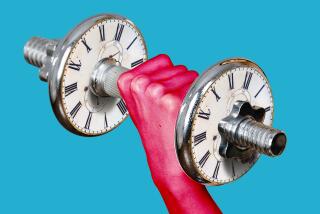Sometimes the Waiting Is the Hardest Part for Youths
- Share via
For every Rex Vollmer, Capistrano Valley High School’s 6-foot 1-inch, 220-pound defensive tackle, there are 20 scrawny freshmen or sophomores who wished they were like him.
Vollmer could bench press 260 pounds in eighth grade. This past summer, before his sophomore year, he benched 315. He’s a varsity starter and Cougar coaches project that, in two years, he’ll be a good college prospect in either football or wrestling.
But Vollmer is the exception. Few 15-year olds can lift the kind of weight he does. Most don’t have the physical capacity to lift half the weight he does.
Still, the little men swarm high school weight rooms, pumping iron, with dreams of earning a starting position on the football team and, perhaps, a college scholarship. They also work with free weights at home, hoping to improve their physique.
But what most of these youngsters don’t realize is that lifting weights at an early age may not be very beneficial. In fact, in some cases, it may be detrimental.
Studies in the area of weight training for pre-pubescent children are rather inconclusive. While some sports physiologists suggest that it may enhance performance, others wonder if it does much good.
But most experts agree that, if not done properly and within reason, weight training at a young age can definitely be harmful.
Their advice: Don’t overdo it.
Too many youngsters, they say, believe that more is better in the weight room. At the impressionable ages of 13 through 15, many youths believe that if they can increase muscle mass, they’ll improve their self-esteem and, hence, their relationships with peers should improve.
While many high school training programs are supervised by coaches who have expertise in weight lifting, many kids will work with free weights at home. They may get challenged by friends who say they can lift more, and contests usually ensue.
But when a youngster tries to lift weights he is incapable of handling, he is risking injury.
The most vulnerable areas to injury are the growth centers at the ends of bones and tendons--known as apophyses--around the heel, knee, hip, spine, shoulder, elbow and wrist. In each locale, a variety of aches and pains can develop from athletic stress.
“If a father wants his son to perform better, he may put him in a rope jumping program or put ankle weights on him while he runs,” Dr. Wayne Leadbetter, a Washington D.C. sports medicine expert, said. “Junior will do that, but he may have so much pain in his ankles and legs that he can’t walk.”
Said Dr. Dave Costill, who runs the Human Performance Lab at Ball State in Muncie, Ind.: “Whether it’s distance running or playing football or baseball, bodies are built to tolerate only so much stress. If they are over-extended, they’re probably going to suffer some injury.
“Most injuries would be acute inflammations or irritations of tendons, but the body is pretty much capable of repairing that damage. But if there is damage to the joints, they don’t come back like elastic tissues.”
Teen-agers going through growth spurts are particularly susceptible to injury because, during those periods, they have less flexibility in their joints and tendons. Leadbetter stresses that training programs for youngsters must be accompanied by stretching exercises.
He recommends that any weight-training program for pre-pubescent youngsters should be done with body proportional devices, which only generate the resistance they put in. He tells young athletes to practice calisthenics instead of concentrating only on weights.
He doesn’t recommend free weights.
They’re tricky to lift, especially for youngsters. Some free-weight maneuvers, such as the clean-and-jerk motion, can cause stress fractures in the lower back vertebrae. Those are just a few of the dangers.
About two years ago, Leadbetter said, an 18-year old in Washington D.C. suffocated after his neck was pinned by a free-weight bar. Leadbetter recently was in the University of Michigan weight room when a 300-pound lineman couldn’t lift a 400-pound bar off his chest.
“Fortunately, there was a trainer and a few other players around,” Leadbetter said. “It took three of us on each end of the bar to lift it high enough to free the player. If you stay around free weights enough, you’ll realize how treacherous they are.”
Said Dave Elecciri, Capistrano Valley High weight coach: “I hear parents say they’re going to get their kids a weight set, and that worries me. They all want to lift so much, but there’s only one way to get there--through safety and proper technique.”
There are other possible negative side effects.
Dr. Ken Cooper, of the Cooper Sports Clinic in Dallas, has a 16-year-old relative in Oklahoma who built tremendous muscle mass through weight lifting and was recognized as the strongest person at his high school.
“Someone is constantly trying to jump him or beat him up because of his reputation,” Cooper said. “It’s a matter of other kids wanting to be the King of the Hill. He’s a nice kid with a nice demeanor, but in looking at his problems, they could happen to anyone.”
More to Read
Get our high school sports newsletter
Prep Rally is devoted to the SoCal high school sports experience, bringing you scores, stories and a behind-the-scenes look at what makes prep sports so popular.
You may occasionally receive promotional content from the Los Angeles Times.







